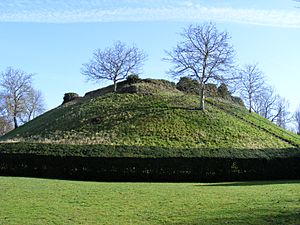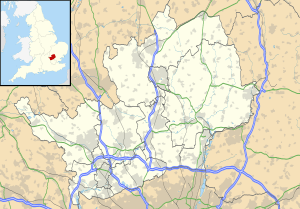Waytemore Castle facts for kids
Quick facts for kids Waytemore Castle |
|
|---|---|
| Bishop's Stortford, Hertfordshire | |

The castle motte
|
|
| Coordinates | 51°52′19″N 0°09′47″E / 51.871934°N 0.162959°E |
| Type | Castle Ruins |
| Site information | |
| Owner | Bishop's Stortford Town Council |
| Open to the public |
On Request |
| Condition | Ruins |
| Site history | |
| Built | c.12th Century |
| Built by | Normans |
| Materials | Stone |
Waytemore Castle is a ruined castle located in the town of Bishop's Stortford in Hertfordshire, United Kingdom. Its remaining parts are considered a very important historical site, known as a Grade I listed structure.
This castle started as a "motte and bailey" castle during the time of William the Conqueror. A motte is a large earth mound, and a bailey is a walled courtyard next to it. In the 12th century, a rectangular stone tower was added on top of the motte. The castle was made even stronger in the 13th century when King John was in charge. Later, in the mid-14th century, the castle was given permission to add "crenellations" – these are the gaps and raised parts on top of castle walls that defenders could shoot through.
After the English Civil War, parts of the castle were deliberately destroyed so it couldn't be used as a fortress anymore. In the 17th century, it was even used as a prison. Today, you can only see the earth mounds, the large motte, and the foundations (bottom parts) of a square tower.
Contents
What is Waytemore Castle?
Waytemore Castle is an old castle that is now mostly ruins. It is found in Bishop's Stortford, a town in Hertfordshire, England. The most noticeable part of the castle today is a big earth mound, which was once the base for the main tower.
A Look at the Castle's History
Some historians think that the mound where Waytemore Castle stands might have been used long before the castle was built. They believe it could have been a Celtic "barrow," which is a grave mound from ancient times. Others suggest it was a Saxon "buhr," a type of fortress with a moat and wooden walls. This Saxon fort might have been improved by Edward the Elder in the early 10th century to protect against Danish invaders.
The name "Waytemore" itself has an interesting history. It was once thought to come from old Saxon words meaning "a place of ambush" and "marsh." However, a historian named Jacqueline Cooper believes the name might come from Old Norse words. She suggests "waite" could be from "thwaite," meaning a "forest clearing," and "marr," meaning a "boggy place." If this is true, it means the Norman castle was built on a site that was cleared from damp woodland.
How the Castle Was Built
Whether the castle was first built by Saxons or Normans, it likely changed from a wooden fort to a stone castle soon after 1086. However, the main tower, called the keep, probably wasn't built until around 1135. The large earth mound became the base for the typical Norman "motte and bailey" castle. It was built in a valley, which was unusual, but it was done on purpose to control an important river crossing nearby.
The castle's mound is about 42 feet (13 meters) high and was surrounded by a moat (a ditch filled with water). The top of the mound was protected by a thick stone wall, made of flint and rubble, about 9 feet (2.7 meters) thick. The keep, built later, was probably 60 to 70 feet (18 to 21 meters) tall and stood inside this wall. To show off Norman power to the local Saxon people, the outside walls of the keep were likely painted white using a mix of lime and chalk.
Archaeologists have found foundations made of flint and rubble, which suggest the keep was rectangular. However, its northern end was curved and built with a mix of Roman bricks and medieval tiles.
What Remains Today?
The parts of the wall that you can still see at the top of the mound are from the castle's keep, which was rebuilt by King John in 1214. The original well, located in the southwest corner, is now covered by a large steel plate for safety.
The mound has never been fully dug up by archaeologists. In 1850, an investigation did uncover parts of the existing wall and some human bones. A local historian, J. L. Glasscock, tried more small digs in 1900 but only found a few old Roman coins. The most interesting discovery happened by accident in the late 1990s when many human bones were found in the castle grounds. Experts believe this strongly suggests there might have been a medieval hospital connected to the castle.
Images for kids



